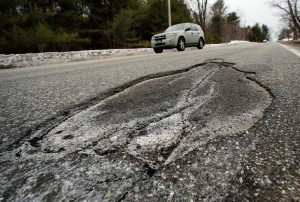Damaged pavement surfaces, characterized by cracks and potholes are probably one of the significant nuisances and a safety hazard. They pose risks to vehicles and pedestrians as well as they deteriorate further if left unaddressed.
Therefore, proper maintenance, care & protection, and timely repairs are essential to extend the life of your pavement and ensure safety.
Today, we are going to suggest some amazing practical tips that can help you fix damaged pavement surfaces effectively.
1. Assess the Damage
Before you start any repair work, make sure you carefully assess the extent of the damage. Now this would involve identifying the type of cracks (e.g., hairline, alligator) and the size and depth of potholes. Conduct a thorough assessment so you can determine the appropriate repair method and materials needed. It’s also a good idea to document the damage through photos and notes as it will help you or the repairer to plan the repair process.
2. Clean the Area
Proper cleaning is one of the fundamental steps before any repair. Remove debris, loose material, and dirt from the cracks and potholes using a broom, air blower, or pressure washer. This ensures that the repair materials adhere properly to the pavement surface. For cracks, use a wire brush to remove any vegetation or stubborn debris.
3. Do Not Forget to Choose the Best Repair Method
The repair method you choose will depend on the type and extent of the damage:
For Small Cracks:
- Crack Sealing: This is ideal for minor cracks less than 1/4 inch wide. Use a crack sealant or filler, which can be found in caulk tubes or pourable form. Apply the sealant, smoothing it with a putty knife to ensure it is level with the pavement surface.
- Crack Filling: For cracks between 1/4 inch and 1 inch wide, use a rubberized asphalt-emulsion crack filler. This method is more durable than crack sealing and can accommodate slight movements in the pavement.
For Larger Cracks and Potholes:
- Patching: Potholes and larger cracks require more substantial repairs. A cold patch asphalt is a convenient option for DIY repairs. It comes ready to use and is easy to apply. For larger areas, hot mix asphalt may be more suitable but typically requires a professional application.
- Infrared Asphalt Repair: This method uses infrared technology to heat the damaged area, allowing for seamless blending of new and existing asphalt. It’s effective for localized damage and results in a durable, smooth repair.
4. Repairing Cracks
For cracks, follow these steps:
- Clean the Crack: Remove all debris and vegetation. Use a wire brush and compressed air to ensure the crack is clean.
- Apply the Filler: Using a crack filler or sealant, fill the crack. Overfill slightly to allow for settling.
- Smooth the Surface: Use a putty knife or trowel to smooth the surface of the filler, ensuring it is level with the surrounding pavement.
- Cure Time: Allow the filler to cure according to the manufacturer’s instructions. This usually involves keeping the area dry and avoiding traffic for a specified period.
5. Repairing Potholes
For potholes, follow these steps:
- Clean the Pothole: Remove all loose debris and standing water. Ensure the edges are clean and free from loose material.
- Apply a Tack Coat: For better adhesion, apply a tack coat (asphalt emulsion) to the edges and bottom of the pothole.
- Add Patch Material: Fill the pothole with cold patch asphalt, slightly overfilling it to allow for compaction.
- Compact the Material: Use a tamper, shovel, or even a car tire to compact the patch material firmly. Proper compaction is crucial for a durable repair.
- Level the Surface: Ensure the patched area is level with the surrounding pavement to prevent trip hazards and ensure smooth driving.
6. Sealcoating
Sealcoating is a preventive measure that can protect your pavement from future damage. It involves applying a protective layer over the entire surface, which helps to shield it from the elements, UV rays, and chemical spills. Sealcoating should be done every 2-3 years to maintain the integrity of your pavement.
7. Routine Maintenance
Regular maintenance is key to prolonging the life of your pavement. This includes:
- Regular Inspections: Periodically inspect your pavement for new cracks and potholes, especially after extreme weather conditions.
- Cleaning: Keep the surface clean from debris, leaves, and standing water. This prevents moisture from seeping into cracks and causing further damage.
- Sealcoating: As mentioned earlier, regular seal coating helps protect your pavement from the elements.
8. Professional Help
While DIY repairs can be effective for minor damage, significant or widespread issues often require professional intervention. Professional pavement contractors have the expertise and equipment to perform high-quality, long-lasting repairs. They can also provide valuable advice on maintenance and prevention strategies tailored to your specific pavement needs.
9. Safety Considerations
When performing repairs, safety should always be a priority. Wear appropriate personal protective equipment (PPE) such as gloves, safety glasses, and high-visibility clothing. If working on a roadway or busy parking lot, use proper signage and barriers to alert and protect both workers and pedestrians.
10. Environmental Considerations
Consider using environmentally friendly materials and methods for your repairs. Many modern asphalt and sealant products are designed to be more eco-friendly, reducing the environmental impact of pavement maintenance. Proper disposal of old materials and debris is also important to minimize environmental harm.
Conclusion
Fixing damaged pavement surfaces with cracks and potholes is essential for maintaining safety and extending the lifespan of your pavement. By assessing the damage, choosing the right repair methods, and performing regular maintenance, you can keep your pavement in excellent condition.
Whether you choose to tackle the repairs yourself or hire a professional in Phoenix, AZ, taking timely action will save you money and prevent more extensive damage in the long run. Remember, a well-maintained pavement is not only functional but also enhances the overall appearance of your property.




